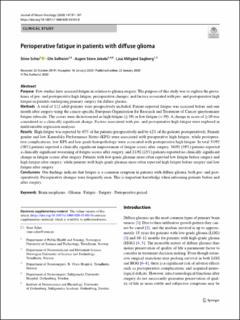| dc.contributor.author | Schei, Stine | |
| dc.contributor.author | Solheim, Ole | |
| dc.contributor.author | Jakola, Asgeir S | |
| dc.contributor.author | Sagberg, Lisa Millgård | |
| dc.date.accessioned | 2021-04-27T07:51:04Z | |
| dc.date.available | 2021-04-27T07:51:04Z | |
| dc.date.created | 2020-01-26T15:33:11Z | |
| dc.date.issued | 2020 | |
| dc.identifier.issn | 0167-594X | |
| dc.identifier.uri | https://hdl.handle.net/11250/2739781 | |
| dc.description.abstract | Purpose
Few studies have assessed fatigue in relation to glioma surgery. The purpose of this study was to explore the prevalence of pre- and postoperative high fatigue, perioperative changes, and factors associated with pre- and postoperative high fatigue in patients undergoing primary surgery for diffuse glioma.
Methods
A total of 112 adult patients were prospectively included. Patient-reported fatigue was assessed before and one month after surgery using the cancer-specific European Organization for Research and Treatment of Cancer questionnaire fatigue subscale. The scores were dichotomized as high fatigue (≥ 39) or low fatigue (< 39). A change in score of ≥ 10 was considered as a clinically significant change. Factors associated with pre- and postoperative high fatigue were explored in multivariable regression analyses.
Results
High fatigue was reported by 45% of the patients preoperatively and by 42% of the patients postoperatively. Female gender and low Karnofsky Performance Status (KPS) were associated with preoperative high fatigue, while postoperative complications, low KPS and low-grade histopathology were associated with postoperative high fatigue. In total 35/92 (38%) patients reported a clinically significant improvement of fatigue scores after surgery, 36/92 (39%) patients reported a clinically significant worsening of fatigue scores after surgery, and 21/92 (23%) patients reported no clinically significant change in fatigue scores after surgery. Patients with low-grade gliomas more often reported low fatigue before surgery and high fatigue after surgery, while patients with high-grade gliomas more often reported high fatigue before surgery and low fatigue after surgery.
Conclusions
Our findings indicate that fatigue is a common symptom in patients with diffuse glioma, both pre- and postoperatively. Perioperative changes were frequently seen. This is important knowledge when informing patients before and after surgery. | en_US |
| dc.language.iso | eng | en_US |
| dc.publisher | Springer | en_US |
| dc.rights | Navngivelse 4.0 Internasjonal | * |
| dc.rights.uri | http://creativecommons.org/licenses/by/4.0/deed.no | * |
| dc.title | Perioperative fatigue in patients with diffuse glioma | en_US |
| dc.type | Peer reviewed | en_US |
| dc.type | Journal article | en_US |
| dc.description.version | publishedVersion | en_US |
| dc.source.journal | Journal of Neuro-Oncology | en_US |
| dc.identifier.doi | 10.1007/s11060-020-03403-0 | |
| dc.identifier.cristin | 1782202 | |
| cristin.ispublished | true | |
| cristin.fulltext | original | |
| cristin.qualitycode | 1 | |

